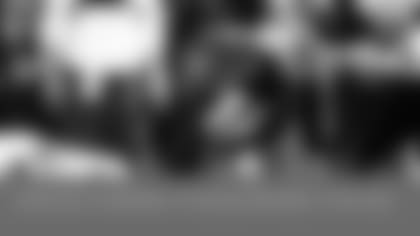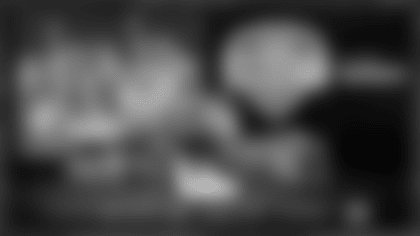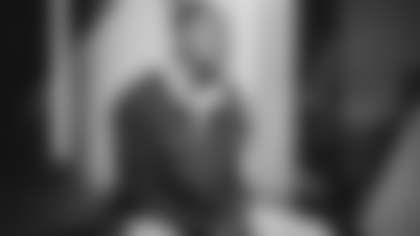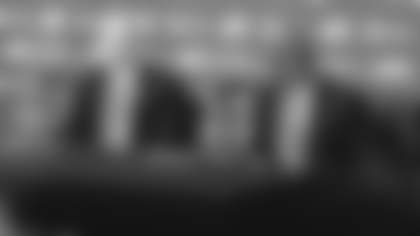Jets Receive an A
The following is an article written by Real Football Services. They will be a frequent contributor on newyorkjets.com.
"With the fourth selection in the 2006 NFL Draft, the New York Jets select….D'Brickashaw Ferguson, offensive tackle, University of Virginia."
And for the first time in recent memory, the Jets fans cheered, as well they should have. Ferguson was the first of several strong selections the Jets made last weekend in what may turn out to be a very strong initial showing for Mike Tannenbaum, Eric Mangini, and company.
With their two first round selections, the Jets solidified a questionable offensive line group. By taking Ferguson and Ohio State OC Nick Mangold, they not only upgraded the tackle and center positions, but created a ripple effect that will strengthen the entire unit for years to come. Ferguson is expected to be in the class of Walter Jones (Seattle), Jonathan Ogden (Baltimore), and Orlando Pace(St. Louis); a perennial all-pro and ten-year starter at LT. He has strength, quickness, outstanding technique, and has the ability to be a dominating blocker in the running game and as a pass blocker. But while he gives the Jets a cornerstone type player, an anchor for the line, his selection also allows the team to move their second-best young O-lineman, Adrian Jones, back to his natural position at RT, upgrading two positions for the price of one.
Mangold is built in the mold of Denver's all-pro center Tom Nalen. He's not the biggest center in the league, but he is an athletic, hard-nosed player, and also scored a stellar 35 on his Wonderlic test. The two most important factors for a Bill Parcells-Bill Belichick-Eric Mangini/Mike Tannenbaum player are toughness and intelligence, and Mangold has heaps of both of those traits. His selection also allows the Jets to leave Pete Kendall at OG along with Brandon Moore, and if he can develop quickly into a starter, allows 9th-year veteran Trey Teague to be the swing man that so many coaches want on the line. Teague has played center, guard, and tackle during his career and can be a valuable fill in at any of those positions. He and a host of other free agent pickups give the Jets needed depth for a group that has quickly gone from being a weakness, to potentially growing into one of the strengths of this team.
The second round may have been as good as the first. Oregon QB Kellen Clemens has been considered a first round talent by many scouts. However, he broke his ankle in October, which caused him to miss the last four games of the season and much of the pre-draft workout season, which had a negative effect on his draft status. With Chad Pennington's health and Patrick Ramsey's ability to fill a starter's role in New York in question, Clemens was a smart pick. Most scouts had him graded ahead of Alabama's Brodie Croyle and Clemson's Charlie Whitehurst, and if not for the injury, he might have put up bigger numbers and been a sure first rounder.
But in addition to the great value Clemens brings, the Jets braintrust made a shrewd move in trading down from their 35th overall selection and moving down to Washington's 49th spot. In the deal, New York not only picked up a sixth round pick that they didn't have prior to the draft, they also got a 2nd round selection in next year's draft, putting the Jets in a position to draft three of the top 64 players for a second year in a row. The value of a move like that is sometimes lost on fans, but not in football circles where the trade has been applauded.
In the third round the Jets went with two defensive players who some teams might have had ranked a bit lower than a 3rd round grade. However, both of these players are "system guys" who fit the Jets new 3-4 defensive scheme. Having addressed their needs on the O-line and at QB in the first two rounds, they had the flexibility to reach a bit for Ohio State ILB Anthony Schlegel and Michigan State S Eric Smith, and avoid missing out on two players that they liked. Again, Schlegel and Smith fit the mold with scores of 31 and 33 on their Wonderlic's, respectively. Both have adequate size, and are not particularly athletic, but both are good, hard-nosed football players with excellent instincts and tackling skills who will be key in run support. These two selections show the Jets building their defense and creating "strength up the middle" as in the old baseball analogy. Their ability to develop into front line players will play a large role in determining the success of this draft down the line.
The third round gamble was made possible by the selection of Missouri WR Brad Smith and Florida State RB Leon Washington in round four. Both players carried day one grades on most draft boards, and have the ability to fill several needs for the Jets. Smith is a 6-2, 213 pounder with 4.4 speed and unlimited potential. Despite playing QB in college, he has that Randle-El factor and can be used as a WR, RB, or returner, and could possibly save a roster spot down the line as the team's 3rd QB.
At 5-7, 204, Washington is undersized, but has all the tools to be an excellent 3rd down change of pace back. He has the speed and quickness to get outside and make defenders miss on the perimeter, and could eventually be a nice complement to Cedric Houston on the inside when Curtis Martin's days are over. Washington is also a solid receiver out of the backfield and have an impact in the return game as well. Much like Reggie Bush, Washington must be used properly, in ways that make the most of his strengths, in order to be successful at the NFL level.
Fifth round TE Jason Pociask is another player who seems to fit the Belichick mold that many people expect Mangini to follow. Though he spent most of his career at Wisconsin as a backup, he is a versatile player who played TE, FB, and contributed on special teams. He's not a deep threat, but shows the ability to get open, has good hands and is a strong blocker. The Jets will stockpile TE's, especially those who can provide varied skills, who will allow them to implement multiple offensive packages.
The team added some late depth picks in the 6th and 7th rounds, but overall had what many prognosticators are calling one of the better showings of the weekend. The team entered the weekend with eight picks and finished with ten, but also added a 2nd round pick for next year's draft. They added two cornerstone players on the O-line, and created good depth at several positions. But the success of this year's draft will ultimately be decided by the development of the five players they selected in rounds two through four.
Remember, Clemens doesn't have the strongest arm, but he is a smart player who has a certain swagger and playmaking ability. If he can develop into a potential starter, if Schlegel and Eric Smith can grow into starting roles, and if Brad Smith and Washington can fill special needs in the offense in the next few years, this year's Jets draft will be held in even higher regard.
*Real Football Scouting Grade: A *














